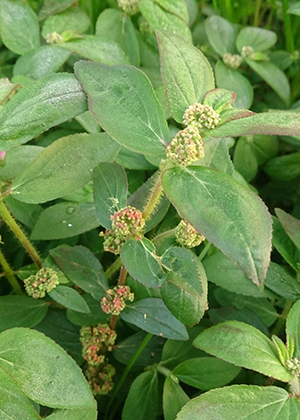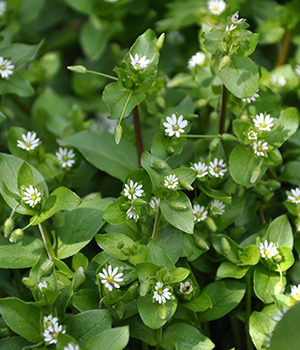Your complete weed guide
Identifying a garden weed, and understanding its growth and life cycle, can help you work out a control strategy.
Here are some of the weeds most commonly encountered in Sydney or other temperate and coastal gardens, with tips on how to recognise and control them using chemicals or physical methods, or both. Remember, when using herbicides, always follow the recommended application rates and times. Repeat applications are normally needed.
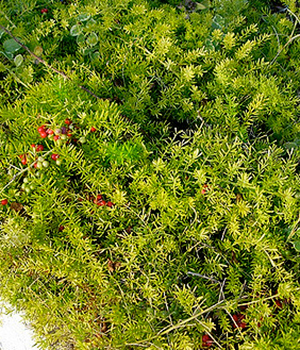 Asparagus fern (Asparagus aethiopicus)
Asparagus fern (Asparagus aethiopicus)
Description: A clumping perennial plant with long, arching, spined stems covered with small, bright green, needle-like leaves giving the plant a fern-like appearance. It produces spires of white, perfumed flowers from spring to autumn followed by berries that ripen to red. Once grown as an ornamental, it is now an invasive weed.
Life cycle and reproduction strategies: Grows year round from persistent white tubers and rhizomes. Also spreads via berries.
Control: Remove flowers and fruit and bag them up so they don’t spread. Dig out the entire clump, removing all tubers. Watch for regrowth and remove any seedlings or suckers. Cover weeded areas with mulch.
Asthma weed, pellitory, sticky weed (Parietaria judaica)
Description: Small, perennial, many-branched weed (can reach 1m high but is usually smaller) with round, green, slightly hairy leaves that feel sticky, and small, green, pollen-filled flowers which appear throughout the year, but particularly in spring. Flowers cluster along the pink or red leafy stems. Commonly found growing from cracks in walls and paving, this weed can trigger asthma and hay fever attacks due to the pollen it produces, and may also irritate skin.
Life cycle and reproduction strategies: Reproduces rapidly from seed. New plants may grow and start flowering within 2-3 weeks. Also regrows from roots left behind if the plant isn't fully pulled out. The seeds spread by wind, water, on clothes and in pet fur.
Control: Difficult to control by weeding alone. Responds well to glyphosate-based herbicides. Treat plants before flowering to reduce spread. Re-treat seedlings or hand-weed regularly. Don’t attempt to weed if you suffer from asthma or hay fever.
 Bindii (Soliva sessilis)
Bindii (Soliva sessilis)
Description: A small, low-growing annual weed with a rosette of bright green, fern-like leaves commonly found in grass and compacted soils. Small green flowers form in the middle of the plant and quickly form sharp burrs, which stick into bare feet, shoes and animal’s paws.
Life cycle and reproduction strategies: Leaves appear in autumn and winter and quickly begin to flower and set seed. The plant dies back in late summer, leaving behind the burrs, which contain the seeds for the next autumn’s growth.
Control: Treat infested lawns in autumn or winter before burrs form using a systemic herbicide for this weed (sold as Bindii and Clover Weeder), which does not kill lawn grass. Once the seeds have formed (usually in late winter or very early spring) but are still green, hand weed to remove the entire plant and immature seeds. Place weeds into the garbage, not into compost bins. As bindii is often worse in compacted soils, aerate and fertilise lawns to encourage strong lawn growth.
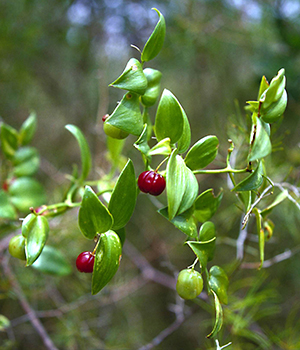 Bridal creeper (Asparagus asparagoides)
Bridal creeper (Asparagus asparagoides)
Description: A soft, creeping or climbing plant with tiny white flowers and small, bright green, shiny leaves. Once grown as an ornamental, it is now considered an invasive weed. This plant grows from a persistent rhizome.
Life cycle and reproduction strategies: Spreads by underground rhizomes and tubers, and quickly forms large clumps that can smother other growth. Also spreads by seed, which can stick to machinery, clothing and animal fur.
Control: Dig out the entire clump removing all tubers, rhizomes and roots. Bag all material to reduce spread. Watch for regrowth and seedlings, and remove or spray with a glyphosate herbicide. Cover weeded areas with mulch and replant.
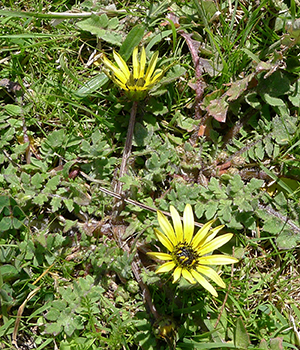 Capeweed (Arctotheca calendula)
Capeweed (Arctotheca calendula)
Description: An annual flatweed with rosettes of broad grey-green hairy leaves and short-stemmed yellow daisy flowers with a black centre. Often found in lawns. Rosettes can be 80cm across.
Life cycle and reproduction strategies: Appears in autumn and winter, gradually forming a large rosette with flowers in spring and summer. Spreads by seed.
Control: Spot-treat with glyphosate herbicide or an organic herbicide based on pelargonic acid before flowering, or use a fork to hand-weed before seeds form.
Chickweed (Stellaria media)
Description: A small, soft-stemmed, annual creeping weed most often found in damp, moist gardens or lawns. It has bright green leaves, tiny white flowers and weak stems.
Life cycle and reproduction strategies: Can grow year-round but is most commonly seen in winter and spring, dying back as temperatures warm. Spreads by seed.
Control: Can be hand-weeded, taking care to remove plants from the base to uproot. Can be fed to chooks and birds. This weed is difficult to control with herbicides as it is usually growing among other plants, but could be spot-treated with glyphosate or an organic herbicide based on pelargonic acid.
 Creeping oxalis (Oxalis corniculata)
Creeping oxalis (Oxalis corniculata)
Description: A tiny, creeping perennial weed of lawns and garden beds. It has small trifoliate leaves and tiny yellow flowers. Leaves are usually green, but may be red or bronze.
Life cycle and reproduction strategies: Grows and flowers throughout the year. Forms small, green, explosive seed heads. Also spreads by underground stems (rhizomes), which may be pink, white or brown.
Control: Simply weeding top growth does not remove this weed, which can regrow from rhizomes and also spreads by seed. Remove all plant parts to control. Can be controlled with systemic herbicide sold as Bin-Die. Spot treat with glyphosate or an organic herbicide based on pelargonic acid (sold as Slasher).
 Dandelion (Taraxacum officinale)
Dandelion (Taraxacum officinale)
Description: A perennial weed forming a flat rosette of scalloped green leaves and tall tubular stems of small flat yellow flowers. The seedhead is a distinctive round ball of seeds referred to as a ‘dandelion clock’. These weeds are often found in lawns. All parts of dandelion are edible. The flowers are a valuable food source for bees and beneficial insects.
Life cycle and reproduction strategies: Grows and flowers year-round, but flowers prolifically in early spring. Seeds float on wind.
Control: Use a selective herbicide for flatweeds, spot treat with glyphosate or hand-weed before flowering. When hand-weeding, remove entire taproot (main root). To control flowers and seedlings without removing plants, simply mow.
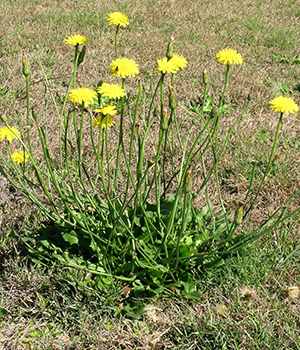 Flatweed, catsear (Hypochoeris radicata)
Flatweed, catsear (Hypochoeris radicata)
Description: A perennial weed forming a flat rosette of green, usually hairy leaves with tall, branching stems of small, flat, yellow, dandelion-like flowers. Often found in lawns.
Life cycle and reproduction strategies: Grows and flowers year-round, but flowers prolifically in spring and early summer. Seeds float on wind. May be an annual in dry climates.
Control: Use a selective herbicide for flatweeds, spot-treat with glyphosate or hand-weed before flowering. To control flowers and seedlings without removing plants, simply mow.
 Fleabane (Conyza)
Fleabane (Conyza)
Description: A perennial flatweed with hairy green leaves and a tall stem of small yellow flowers, followed by large numbers of fluffy seedheads. Plants can be 1m high with woody stems.
Life cycle and reproduction strategies: Spreads by seeds blown on the wind.
Control: Many species are resistant to herbicides. Hand-weed small plants. Dig out larger plants before seeding. Cover bare soil to prevent windblown seeds germinating.
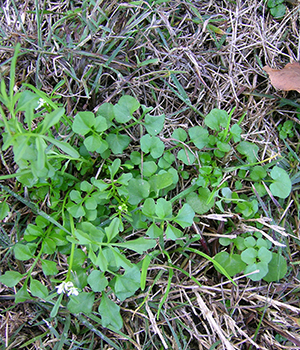 Flickweed (Cardamine hirsuta)
Flickweed (Cardamine hirsuta)
Description: This tiny weed (around 10-15cm high) with a branching flower reproduces itself very quickly, often setting seed and re-growing in a matter of weeks. Often a weed of nurseries and potted plants.
Life cycle and reproduction strategies: Produces explosive seed capsules that disperse seed. Most prolific in spring and early summer.
Control: Avoid bringing it into the garden with potted plants. Pull up seedlings as soon as they are seen and put in a bag. If there are seed capsules, avoid triggering the pod to split. Can also be controlled with a herbicide such as glyphosate, applied before seeds form.![]()
 Lantana (Lantana camara)
Lantana (Lantana camara)
Description: A large shrub with square, woody, prickly stems, small rough leaves and clusters of pink, orange or red flowers followed by green berries that ripen to black. Flowers can occur throughout the year. Lantana is poisonous to stock and is considered a weed of national significance. All forms of lantana are banned from cultivation and sale.
Life cycle and reproduction strategies: This long-lived shrub spreads by seed, but branches can also form roots allowing this weed to form dense thickets that choke out other plants. Seeds remain viable in the soil for many years.
Control: Hand-weed seedlings or cut back mature growth, then poison stumps and regrowth. Watch for regrowth and seedlings. When clearing large areas that have become habitat for wildlife, clear gradually, replanting with native or non-invasive plants. Cover disturbed soil with mulch to deter seedlings.![]()
 Milk thistle, sow thistle (Sonchus oleraceus)
Milk thistle, sow thistle (Sonchus oleraceus)
Description: An annual thistle with clusters of yellow flowers and lobed, often-spiky leaves. Plants have milky sap and grow 60-90cm high. Seeds prolifically. A favourite green to feed to backyard hens.
Life cycle and reproduction strategies: Flowers and grows throughout the year. Seeds dispersed by wind.
Control: Hand-weed young plants before seeding. Can be controlled with glyphosate or an organic herbicide based on pelargonic acid (sold as Slasher). Treat before flowering. Cover weeded areas with mulch to deter regrowth.
 Nutgrass (Cyperus rotundus)
Nutgrass (Cyperus rotundus)
Description: A green, grassy, perennial plant often found in poorly-drained soils. Spreads by underground rhizomes with small tubers (called ‘nuts’). Also produces an umbrella-shaped flower head in summer and autumn, then sets seed. Plants are 20-50cm high.
Life cycle and reproduction strategies: Spreads rapidly by rhizomes and tubers. Also spreads by seed.
Control: Difficult to control both with herbicides and hand-weeding. Regrows easily from rhizomes and small tubers left in the ground. Try spot treating with repeated applications of glyphosate with added wetting agent, or use a selective herbicide for nutgrass with a wetting agent and follow instructions on container. May need repeated treatments over several years. Cover badly infested areas with newspaper or cardboard to exclude light. Don’t move soil that contains nutgrass to other parts of the garden, and do not put weeds into the compost.
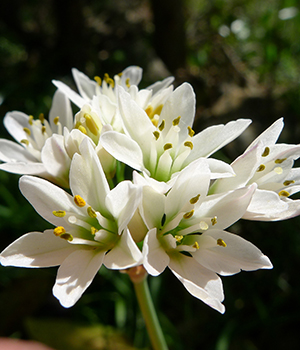 Onion weed (Nothoscordum inodorum)
Onion weed (Nothoscordum inodorum)
Description: A perennial bulb with strappy, green, onion-scented leaves, plus stems of white, lightly fragrant flowers in spring and summer. Found in lawns and garden beds.
Life cycle and reproduction strategies: Flowers and grows throughout the year, but particularly in warmer months. Spreads by bulbs and seeds. Bulbs are surrounded by many small daughter bulbs, some held deeply in the soil.
Control: Control is extremely difficult and requires repeated applications of herbicide including glyphosate, often spot-treating plants over several years. Combine herbicides with physical methods including removing flowering stems to prevent seeding and blanketing infested areas with sheet mulching of newspaper or cardboard. Hand-weed small infestations, digging down to remove all the bulblets. Large infestations area usually made worse by hand weeding so avoid cultivating garden beds containing onion weed and don’t spread soil.
 Oxalis (Oxalis)
Oxalis (Oxalis)
Description: A small, persistent perennial bulb with green clover-like leaves sometimes marked brown. Oxalis pes-caprae (also known as sour sob) has yellow flowers in winter and spring; O. purpurea (pictured) may have pink or white flowers from late spring to autumn. Found in pot plants, garden beds, lawns, orchards and wastelands.
Life cycle and reproduction strategies: Spreads by seed and bulbs, often in soil. Oxalis pes-caprae appears in autumn and winter and dies back in spring. Most other weedy oxalis species grow in spring and summer and die back in autumn.
Control: Oxalis is hard to control. Smaller bulbs surround the main bulb and are triggered when detached from the main bulb by cultivating or hand-weeding. Bulbs can extend 30cm deep into the soil and small bulbs may be the size of a peppercorn. Dig out small patches along with surrounding soil. Any bulbs that remain will grow and spread. In garden beds, remove other plants (washing soil from their roots to avoid spreading small bulbs) then sheet mulch with layers of newspaper or cardboard to exclude light from the soil. Otherwise, turn the area to lawn and mow regularly to weaken the bulb by removing foliage and flowers. Organic control measures take years and can be combined with repeat herbicide applications including glyphosate, spot-treating plants over several years.
 Privet, small and broad leaved (Ligustrum sinense and L. lucidum)
Privet, small and broad leaved (Ligustrum sinense and L. lucidum)
Description: Evergreen shrubs to small trees, privets were once used extensively as hedging. The white to creamy-green flowers have a very unpleasant scent and may cause allergies. They are followed by black berries, which contain seeds. Both forms are weeds differing mainly in their leaf size. Small-leafed privet (pictured has tiny dark-green leaves and grows around 2-3m high; broad-leaved privet has large shiny green leaves and grows 4-10m high.
Life cycle and reproduction strategies: These are long-lived plants with very hard wood. They are spread mainly by birds, which feast on the berries, but can also be spread by garden prunings that are dumped in bushland.
Control: Hand-weed seedlings or spot-treat with herbicide. Prune hedges or garden plants to remove flowers and seeds. Established plants should be cut down and the stump treated with herbicide to prevent regrowth.
 Stinging nettle (Urticaria urens)
Stinging nettle (Urticaria urens)
Description: A tall green herbaceous perennial weed with stems that sting when touched, small round green leaves and tiny white flowers. The stinging sensation is caused by fine hairs along the stem and is very painful. Stinging nettles are a sign of good soils.
Life cycle and reproduction strategies: Often found in disturbed soils. Generally dies down during summer or in dry weather. Seeds prolifically.
Control: Hand-weed or hoe out seedlings (wear gloves and long sleeves to avoid the sting) or spot-treat with herbicide. Treat or weed before seeds form. Young nettles can be eaten as soup (nettle soup). The stings disappear with cooking. Weeded plants can also be soaked in water to make nettle tea – a nutrient-rich liquid feed for plants.
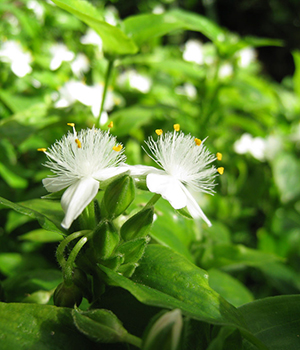 Tradescantia, wandering jew (Tradescantia albiflora T. fluminensis)
Tradescantia, wandering jew (Tradescantia albiflora T. fluminensis)
Description: Ground-hugging, weak-stemmed perennial creeper with narrow shiny green leaves and fleshy, semi-succulent stems. White three-petalled flowers. Carpeting growth that invades other plants. Usually found in shady spots. Causes skin irritation in dogs.
Life cycle and reproduction strategies: Grows year round. Stems root at nodes and any part of the stem or rhizome can grow.
Control: Shiny succulent growth and persistent stems makes control by herbicide hard. Pull or rake up plant and roots. Look for rhizomes under soil and mulch. Remove all plant parts and bag up to avoid dropping small plant pieces, which can regrow. Do not put fresh material in compost. Weeded stems can be soaked in water for a week or until growth rots before being buried or added to compost. Cover bare and disturbed soil with mulch or plantings. Check frequently for regrowth where weed has been removed.
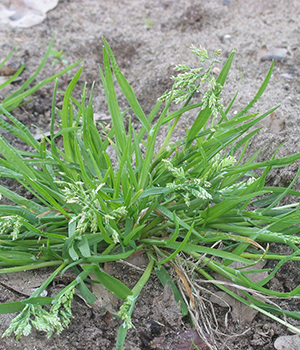 Winter grass (Poa annua)
Winter grass (Poa annua)
Description: A small, annual, bright green grass with fine seed heads. Found in lawns in winter and early spring.
Life cycle and reproduction strategies: Grows and seeds quickly, often completing its growth cycle in three weeks.
Control: Hand-weed or mow before seeding. A useful seed source for birds in winter. Plants die back as weather warms. Can also be controlled with a selective herbicide for winter grass.


